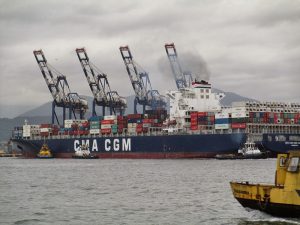 Santos is the port of São Paulo, with more than twelve million inhabitants the largest city in Brazil, located almost eighty kilometers inland. Santos is the most important port of Latin America. It belongs to the largest fifty ports in the world.
Santos is the port of São Paulo, with more than twelve million inhabitants the largest city in Brazil, located almost eighty kilometers inland. Santos is the most important port of Latin America. It belongs to the largest fifty ports in the world.
Before the arrival of Portuguese conquerors, Brazil was a densely populated area, with manioc farming going back thousands of years – older than European agriculture. In 1500, a Portuguese expedition led by Pedro Alvares Cabral accidentally discovered Brazil’s lush and wetland coastal region – the fleet was en route to Indie, but sailed through the trade winds so far west on the Atlantic that they saw land and so they arrived on the place where Santos would later emerge. The Tupiniquim lived there, who exchanged gifts with the Portuguese. In 1532, the coast was colonized and the Tupiniquim were enslaved. “The meeting of Europeans with the indigenous people is the history of a genocide,” writes Eduardo Bueno in his book Brazil. Uma historia.
Among the settlers was a certain Bras Cubas, who was not only interested in his own gain, but also in development. He built moorings for ships, a church, roads, sugar cane plantations and a hospital, the first in Latin America, called Todos los Santos, All Saints: and so the place was given the name Santos. Brazil’s first sugar factory was opened in Santos in 1532. Pirates constantly came to the coast, such as the Englishman Thomas Cavendish in 1591 and the Dutchman Joris van Spilbergen in 1615, who made a trip to the Indies through the Strait of Magellan on behalf of the East India Company. He had been ordered to conquer Spanish possessions along the way wherever he could. He and his crew captured and destroyed Santos, but after a bloody battle on the beach, Van Spilbergen and his men had to flee.
In 1822, Brazil became independent from Portugal. Santos received city rights in 1839. The port grew through the emerging coffee industry; the area around São Paulo became the most important coffee area in Brazil. A large part of the population of Santos worked in the coffee industry. Santos is still the largest coffee exporter in the world.In 1892, a harbor quay was built along the coast of the tropical, mountainous, jungle-like island on which Santos is located, which was expanded over time. The harbor was a magnet that attracted adventurers and entrepreneurs from all over the world. In 1913, nearly 90,000 people lived in Santos, half of whom were foreigners, mostly from European countries and from the United States. In 1917, a striking and beautiful coffee fair was built in Jugendstil style; that is now the coffee museum of Santos.The current harbor is a peculiar combination of cluttered and sometimes abandoned old parts, and modern new harbors across the river. The big problem is the infrastructure; the trucks on the freeways from São Paulo through the mountains to the port are constantly stuck. The port is also connected to the surrounding states by railways, waterways, and a pipeline. Santos is the largest exporter of sugar, orange juice and coffee in the world, and also exports soy, millet, corn, alcohol, cars and industrial products. The main trading partner is China.




